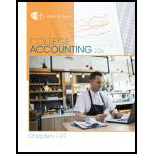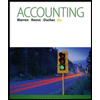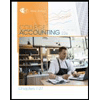
CASH DIVIDENDS, STOCK DIVIDEND, AND STOCK SPLIT During the year ended December 31, 20--, Baggio Company completed the following transactions:
Apr. 15 Declared a semiannual dividend of $0.65 per share on
May 10 Paid the cash dividends.
Oct. 15 Declared semiannual dividend of $0.65 per share on preferred stock and $0.45 per share on common stock to shareholders of record on November 5, payable on November 20.
Nov. 20 Paid the cash dividends.
22 Declared a 10% stock dividend to shareholders of record on December 8, distributable on December 16. Market value of the common stock was estimated at $15 per share.
Dec. 16 Issued certificates for common stock dividend. 20 Board of directors declared a two-for-one common stock split.
REQUIRED
Prepare journal entries for the transactions.
Journalize the given transactions in the books of Company B.
Explanation of Solution
Journal entry: Journal entry is a set of economic events which can be measured in monetary terms. These are recorded chronologically and systematically.
Debit and credit rules:
- Debit an increase in asset account, increase in expense account, decrease in liability account, and decrease in stockholders’ equity accounts.
- Credit decrease in asset account, increase in revenue account, increase in liability account, and increase in stockholders’ equity accounts.
Journalize the given transactions in the books of Company B.
Transaction on April 15:
| Date | Account Titles and Explanation | Post Ref. | Debit ($) | Credit ($) | ||
| 20-- | ||||||
| April | 15 | Cash Dividends | 35,400 | |||
| Preferred Dividends Payable | 3,900 | |||||
| Common Dividends Payable | 31,500 | |||||
| (Record declaration of preferred and common dividends) | ||||||
Table (1)
Description:
- Cash Dividends is a contra-capital temporary account. This account decreases stockholders’ equity and is closed as the dividends are paid off. So, the account is debited.
- Preferred Dividends Payable is a liability account. Since the liability to pay dividends increased, liability increased, and an increase in liability is credited.
- Common Dividends Payable is a liability account. Since the liability to pay dividends increased, liability increased, and an increase in liability is credited.
Working Notes:
Compute amount of preferred dividends declared.
Compute amount of common dividends declared.
Transaction on May 10:
| Date | Account Titles and Explanation | Post Ref. | Debit ($) | Credit ($) | ||
| 20-- | ||||||
| May | 10 | Preferred Dividends Payable | 3,900 | |||
| Common Dividends Payable | 31,500 | |||||
| Cash | 35,400 | |||||
| (Record payment of dividends) | ||||||
Table (2)
Description:
- Preferred Dividends Payable is a liability account. Since the liability to pay dividends has been paid off, liability decreased, and a decrease in liability is debited.
- Common Dividends Payable is a liability account. Since the liability to pay dividends has been paid off, liability decreased, and a decrease in liability is debited.
- Cash is an asset account. The amount is decreased because cash is paid as dividends, and a decrease in assets should be credited.
Note: Refer to Equations (1) and (2) for the value and computation preferred and common dividends.
Transaction on October 15:
| Date | Account Titles and Explanation | Post Ref. | Debit ($) | Credit ($) | ||
| 20-- | ||||||
| October | 15 | Cash Dividends | 35,400 | |||
| Preferred Dividends Payable | 3,900 | |||||
| Common Dividends Payable | 31,500 | |||||
| (Record declaration of preferred and common dividends) | ||||||
Table (3)
Description:
- Cash Dividends is a contra-capital temporary account. This account decreases stockholders’ equity and is closed as the dividends are paid off. So, the account is debited.
- Preferred Dividends Payable is a liability account. Since the liability to pay dividends increased, liability increased, and an increase in liability is credited.
- Common Dividends Payable is a liability account. Since the liability to pay dividends increased, liability increased, and an increase in liability is credited.
Working Notes:
Compute amount of preferred dividends declared.
Compute amount of common dividends declared.
Transaction on November 20:
| Date | Account Titles and Explanation | Post Ref. | Debit ($) | Credit ($) | ||
| 20-- | ||||||
| November | 20 | Preferred Dividends Payable | 3,900 | |||
| Common Dividends Payable | 31,500 | |||||
| Cash | 35,400 | |||||
| (Record payment of dividends) | ||||||
Table (4)
Description:
- Preferred Dividends Payable is a liability account. Since the liability to pay dividends has been paid off, liability decreased, and a decrease in liability is debited.
- Common Dividends Payable is a liability account. Since the liability to pay dividends has been paid off, liability decreased, and a decrease in liability is debited.
- Cash is an asset account. The amount is decreased because cash is paid as dividends, and a decrease in assets should be credited.
Note: Refer to Equations (3) and (4) for the value and computation preferred and common dividends.
Transaction on November 22:
| Date | Account Titles and Explanation | Post Ref. | Debit ($) | Credit ($) | ||
| 20-- | ||||||
| November | 22 | Stock Dividends | 105,000 | |||
| Stock Dividends Distributable | 7,000 | |||||
| Paid-In Capital in Excess of Par–Common Stock | 98,000 | |||||
| (Record declaration of stock dividends) | ||||||
Table (5)
Description:
- Stock Dividends is a contra-stockholders’ equity temporary account. This account decreases stockholders’ equity and is closed to Retained Earnings account as the common stock is issued. So, the account is debited.
- Stock Dividends Distributable is a stockholders’ equity account. Since common stock is declared to be issued as stock dividends, at par value, equity value is increased. An increase in equity is credited.
- Paid-In Capital in Excess of Par–Common Stock is a stockholders’ equity account. Since the stock is issued in excess of par value, equity value is increased. An increase in equity is credited.
Working Notes:
Compute the number of shares to be distributed as stock dividends.
Compute amount of stock dividends (Refer to Equation (5) for stock dividend shares value).
Compute the amount of stock dividends distributable (Refer to Equation (5) for stock dividend shares value).
Compute paid-in capital in excess of par-common stock (Refer to Equations (6) and (7) for stock dividends and stock dividends distributable value).
Transaction on December 16:
| Date | Account Titles and Explanation | Post Ref. | Debit ($) | Credit ($) | ||
| 20-- | ||||||
| December | 16 | Stock Dividends Distributable | 7,000 | |||
| Common Stock | 7,000 | |||||
| (Record issue of stock dividends in the form of common stock) | ||||||
Table (6)
Description:
- Stock Dividends Distributable is a stockholders’ equity account. Since common stock is issued due to declaration of stock dividends, the value is transferred to common stock, the equity value is decreased. A decrease in equity is debited.
- Common Stock is a stockholders’ equity account. Since common stock is issued, equity value is increased. An increase in equity is credited.
Note: Refer to Equation (7) for value and computation of stock dividends distributable value.
Transaction on December 20:
| Date | Account Titles and Explanation | Post Ref. | Debit ($) | Credit ($) | |
| 20-- | |||||
| December | 20 | Memorandum entry: Declared a 2-for-1 stock split. Issued 154,000 shares of $0.50 par common stock in exchange for 77,000 shares of $1 par common stock. | |||
Table (7)
Working Notes:
Compute the number of shares after stock split on December 20.
Compute the par value of shares after stock split.
Want to see more full solutions like this?
Chapter 21 Solutions
College Accounting, Chapters 1-27 (New in Accounting from Heintz and Parry)
- You are the owner of Veiled Wonders, a firm that makes window treatments. Some merchandise is custom-made to customer specifications, and some are mass-produced in standardized measurements. There are production workers who work primarily on standardized blinds and some employees who work on custom products on an as-needed basis. How should you structure the pay methods for these production workers?arrow_forwardGeneral Accounting questionarrow_forwardWilson Corporation acquires Greatbatch Company for $80 million cash in a merger. The balance sheets of both companies at the date of acquisition are as follows: Balance Sheet (in millions) Wilson Greatbatch Current assets $96 $8 Property and equipment 800 144 Intangibles 32 4.8 Total assets $928 $156.8 Current liabilities $40 $3.2 Long-term debt 640 104 Capital stock 80 19.2 Retained earnings 192 24 Accumulated other comprehensive income (loss) (24) 6.4 Total liabilities and equity $928 $156.8 Greatbatch's property and equipment is overvalued by $48 million, its reported intangibles are undervalued by $32 million, and it has unreported intangibles, in the form of customer databases and marketing agreements, valued at $11.2 million. Required Prepare Wilson's balance sheet immediately following the merger. Use a negative sign with your answer for AOCI if the balance is a loss.arrow_forward
- Compare and contrast experiences you have had with your own and other people’s monochromic time orientation and polychronic time orientation and how you can account for any differences in time orientation in your workplace communications in the future.arrow_forwardI need this question answer general Accountingarrow_forwardFinancial accounting questionarrow_forward
 Corporate Financial AccountingAccountingISBN:9781305653535Author:Carl Warren, James M. Reeve, Jonathan DuchacPublisher:Cengage Learning
Corporate Financial AccountingAccountingISBN:9781305653535Author:Carl Warren, James M. Reeve, Jonathan DuchacPublisher:Cengage Learning College Accounting, Chapters 1-27AccountingISBN:9781337794756Author:HEINTZ, James A.Publisher:Cengage Learning,
College Accounting, Chapters 1-27AccountingISBN:9781337794756Author:HEINTZ, James A.Publisher:Cengage Learning, Accounting (Text Only)AccountingISBN:9781285743615Author:Carl Warren, James M. Reeve, Jonathan DuchacPublisher:Cengage Learning
Accounting (Text Only)AccountingISBN:9781285743615Author:Carl Warren, James M. Reeve, Jonathan DuchacPublisher:Cengage Learning College Accounting, Chapters 1-27 (New in Account...AccountingISBN:9781305666160Author:James A. Heintz, Robert W. ParryPublisher:Cengage LearningPrinciples of Accounting Volume 1AccountingISBN:9781947172685Author:OpenStaxPublisher:OpenStax College
College Accounting, Chapters 1-27 (New in Account...AccountingISBN:9781305666160Author:James A. Heintz, Robert W. ParryPublisher:Cengage LearningPrinciples of Accounting Volume 1AccountingISBN:9781947172685Author:OpenStaxPublisher:OpenStax College





